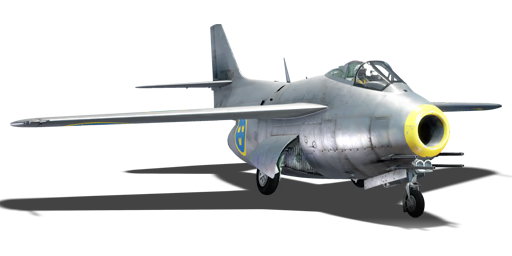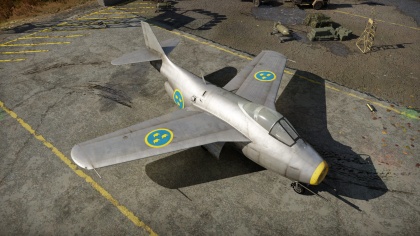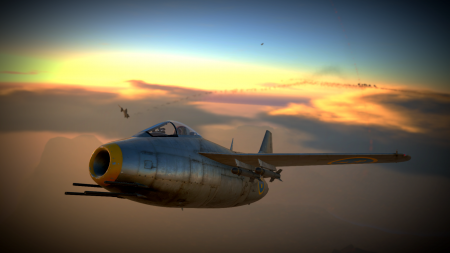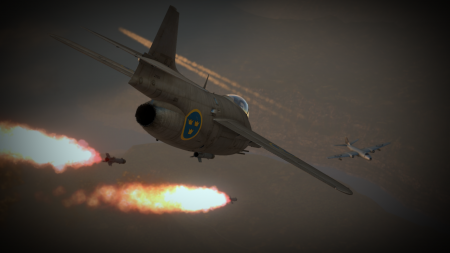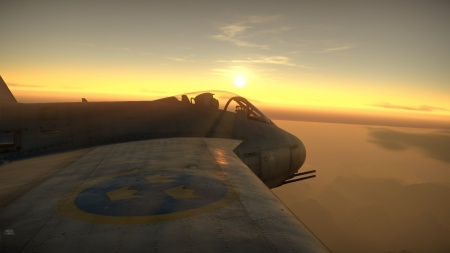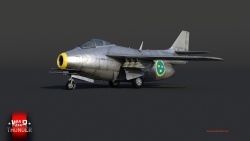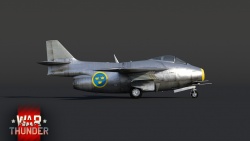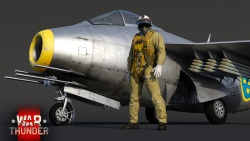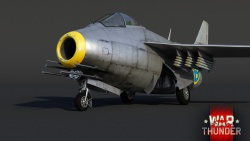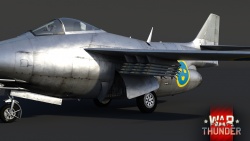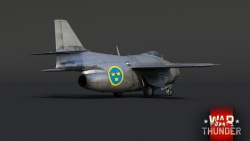Difference between revisions of "J29D"
Colok76286 (talk | contribs) (→Media: Added Shooting Range episode) |
Colok76286 (talk | contribs) (→Media: Corrected typo) |
||
| Line 249: | Line 249: | ||
;Videos | ;Videos | ||
{{Youtube-gallery|YD22i7Y8wHg|'''Saab 29 Tunnan''' - ''jaglavaksoldier''|trg7eAT53uQ|'''Waddington International Airshow 2013, Saab 29 Tunnan''' - '' | {{Youtube-gallery|YD22i7Y8wHg|'''Saab 29 Tunnan''' - ''jaglavaksoldier''|trg7eAT53uQ|'''Waddington International Airshow 2013, Saab 29 Tunnan''' - '' | ||
| − | greeymen''|Xd9m6rPtN3U|'''The Shooting Range # | + | greeymen''|Xd9m6rPtN3U|'''The Shooting Range #172''' - ''Pages of History'' section at 04:57 discusses the Saab J29 Tunnan.}} |
{{break}} | {{break}} | ||
Revision as of 15:12, 15 March 2020
Contents
| This page is about the gift Swedish jet fighter J29D. For other versions, see J29 (Family). |
Description
The J29D Tunnan is a gift rank V Swedish jet fighter
with a battle rating of 9.0 (AB) and 8.3 (RB/SB). It was introduced in Update 1.93 "Shark Attack".
When conjuring up thoughts of fighter jets, many would initially think of a sleek, weapon-laden fast jet which would almost rival a hot-rod in the car world. When presented with the J29D, most people would cock their head to the side with a puzzled look on their face. It's a good thing that fighter jets are not determined by looks alone! The J29D is, for lack of a better phrase, a "wolf in sheep's clothing", initially laughed at as being the "chubby kid on the block". Once up in the air, however, it is quickly realised that this rotund little fighter is a dynamic powerhouse!
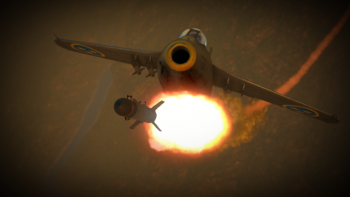
While many other nations were fixated on designing straight-wing aircraft, the Swedes were busy exploiting the knowledge of former Messerschmitt engineers in implementing swept wings onto their fighters. With this and other improvements, the J29D was found to be pretty fast during its trials. Although it was not supersonic, it was pushing 900 km/h. It handled like a dream, being extremely quick and agile. The nose of the aircraft was bristling with four 30 mm ADEN autocannons, and various types of suspended ordnance could be outfitted, including light rockets, heavy anti-ship rockets, air-to-air rockets, and guided missiles. Sweden didn't have the money to develop aircraft specifically for a combat role, so they designed their J29D to do it all and do it well. Depending on the load-out, the J29D could fly like a fighter, interceptor, bomber, or a combination of the three. This functionality comes in very handy as in-game spawns can lead to a map with specific requirements and the pilot will have no problems configuring the weapons of this aircraft to fit the mission, whereas some other contemporary fighters are quite limited in their options.
If not kept in check, the J29D can quickly become the bully on the block hard-charging into the battlefield, wreaking havoc and then departing without a second thought. If two fighters are headed your way, your best bet will be to take out the J29D first or it will likely nab you in the rear and send you down in flames.
General info
Flight performance
When flying the J29D, it is hoped that enemy pilots will take one look, chuckle, and not take the rotund Swedish fighter seriously, only to learn the hard way they were wrong. The J29D has the speed, agility, and ordnance to be considered a powerhouse in the sky. Being outfitted with an afterburning engine, the J29D can fly upwards of 1,000 km/h and climbs up to altitude at a whipping 55 metres per second. This allows the fighter to get in and out of contested areas to engage its targets of choice. This fighter was built for speed and agility and uses these characteristics to show up other aircraft which may be faster or bulkier, sidestepping their attacks and jumping back in to nab the kill. Thanks to the way the four ADEN cannons are mounted when the J29D lines up a target and fires, it is almost like a 30 mm shotgun being fired off. A tight spread of 30 mm rounds heads downfield, and when impacting another aircraft, rarely is there enough left of the plane to fly.
The J29D is as comfortable up at altitude as it is down at just above ground level. The fighter is a stable platform when it comes to ground attack, with good acceleration characteristics when the time comes to peel off the ground targets and manoeuvre back up to altitude with the other fighters. Being specially designed to reduce as much drag as possible, the swept-back wings help extend the breakage limits of the wings, especially when this fighter is in a dive.
| Characteristics | Max Speed (km/h at 0 m - sea level) |
Max altitude (meters) |
Turn time (seconds) |
Rate of climb (meters/second) |
Take-off run (meters) | |||
|---|---|---|---|---|---|---|---|---|
| AB | RB | AB | RB | AB | RB | |||
| Stock | 1,032 | 1,027 | 13500 | 29.2 | 30.8 | 48.8 | 45.3 | 800 |
| Upgraded | 1,048 | 1,040 | 28.7 | 29.0 | 70.6 | 59.0 | ||
Details
| Features | |||||
|---|---|---|---|---|---|
| Combat flaps | Take-off flaps | Landing flaps | Air brakes | Arrestor gear | Drogue chute |
| ✓ | ✓ | ✓ | ✓ | X | X |
| Limits | ||||||
|---|---|---|---|---|---|---|
| Wings (km/h) | Gear (km/h) | Flaps (km/h) | Max Static G | |||
| Combat | Take-off | Landing | + | - | ||
| 1102 | 420 | 520 | 520 | 320 | ~11 | ~5 |
| Optimal velocities (km/h) | |||
|---|---|---|---|
| Ailerons | Rudder | Elevators | Radiator |
| < 650 | < 640 | < 450 | N/A |
Engine performance
| Engine | Aircraft mass | |||||
|---|---|---|---|---|---|---|
| Engine name | Number | Empty mass | Wing loading (full fuel) | |||
| Svenska Flygmotor RM2B | 1 | 4,920 kg | 282 kg/m2 | |||
| Engine characteristics | Mass with fuel (no weapons load) | Max Takeoff Weight | ||||
| Weight (each) | Type | 8m fuel | 20m fuel | 28m fuel | ||
| 1,150 kg | Afterburning centrifugal-flow turbojet | 5,398 kg | 6,136 kg | 6,627 kg | 7,080 kg | |
| Maximum engine thrust @ 0 m (RB / SB) | Thrust to weight ratio @ 0 m (WEP) | |||||
| Condition | 100% | WEP | 8m fuel | 20m fuel | 28m fuel | MTOW |
| Stationary | 2,070 kgf | 2,881 kgf | 0.53 | 0.47 | 0.43 | 0.41 |
| Optimal | 2,070 kgf (0 km/h) |
3,001 kgf (0 km/h) |
0.55 | 0.49 | 0.45 | 0.42 |
Survivability and armour
- Armour
- 64 mm bulletproof canopy windscreen
- 10 mm steel plate behind pilot's seat
- 10 mm steel plate in the nose
The stout little J29D is a sneaky little fighter which might be underestimated during a head-on. A 64 mm bulletproof windscreen is in place, which, since it is sloped, provides 165 mm total protection, allowing the pilot to have a greater chance of survival in a head-on. However, unless highly experienced, pilots should avoid head-ons, especially against aircraft such as the Super Mystere B2 and the G.91 YS which also feature 30 mm DEFA 552 cannons. Make sure to avoid the B2 as well, as the AA.20 air-to-air guided rockets will make the J29D have a hard time standing up to this aircraft.
Armaments
Offensive armament
The J29D is armed with:
- 4 x 30 mm Akan m/55 cannons, nose-mounted (100 rpg = 400 total)
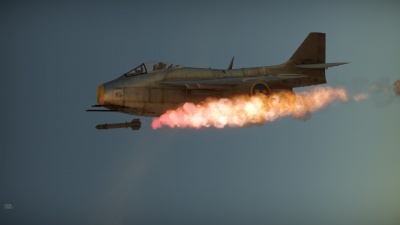
Suspended armament
The J29D can be outfitted with the following ordnance:
- Without load
- 24 x m/55 rockets
- 14 x m/49A rockets
- 14 x m/51 rockets
- 4 x m/49 rockets
Usage in battles
Although the J29D is a fast jet capable of reaching high speed, at the start it can be pretty slow. The J29D has the chance to fight supersonic jets at its battle rating which it can't hunt down by itself. As such, the J29D is best used in teamwork with other jets to either catch up to the enemy plane or make them do manoeuvres to bleed some speed so the J29D can catch up. If faced with subsonic jets, it can keep up with them and stay on its tail thanks to its manoeuvrability. For the daredevils, the J29D has an excellent armament of choice to do head-ons with. These load outs would be best put to use if no teammate around to help you fight the enemy. Because the J29D has slow acceleration at the start of the game, it can have a hard time intercepting enemies at first. As the battle progresses and you will have worked up speed, this task will be made much easier.
The J29D can also be used as an excellent ground attacker for more experienced players who are used to aiming unguided rockets. It has a variety of rockets, allowing you to sufficiently take out a wide variety of targets (light, medium, heavy, etc.). With most loads having more than 10 rockets, an experienced player can take out a few ground targets each spawn. Along with the rockets, the four 30 mm guns, given the proper belt choice, can inflict heavy damage upon soft and somewhat hard targets as well.
Even as an excellent fighter, the J92D has dangerous enemies, mainly high-subsonic jets like MiG-17 and anti-air missile firing jets like G.91 YS and Swift F.7.
Modules
| Tier | Flight performance | Survivability | Weaponry | ||
|---|---|---|---|---|---|
| I | Fuselage repair | Offensive 30 mm | m/55 | ||
| II | Compressor | Airframe | m/49A | ||
| III | Wings repair | New 30 mm cannons | m/51 | ||
| IV | G-suit | Engine | Cover | m/49 | |
Pros and cons
Pros:
- Fast and agile
- Multi-role aircraft (fighter/attacker/interceptor)
- Four nose-mounted 30 mm Akan autocannons
- Accelerates well in a climb
Cons:
- Loses its agility at high speeds
- Tends to up-tiered against planes which are faster
- Bleeds through ammunition quickly - requires trigger patience
History
Following World War II, Sweden felt that they had fallen behind in technological advancements when it came to military aircraft and strove to rectify the situation while beefing up they considered was their current weak air defence. Jet propulsion technology was cutting-edge and Sweden was not to be left out. In 1945, Sweden's leading aeronautical firm began to work on design ideas of potential future fighter aircraft. Through a design contest, a clear winner emerged which was a barrel-shaped fighter which promised to be the faster and more agile of the proposed aircraft, this fighter was given the codename "R 1001".
Initially designed with a straight wing, newly acquired German research data and even some Messerschmitt engineers themselves who fled to Sweden made the recommended change to wings with a 25-degree sweep, which highly stabilized and reduced the aircraft's drag as it approached the sound barrier. Adding to the aerodynamics of the wing shape, it was decided to not house the landing gear in the wings, but instead to have them retract into the fuselage of the aircraft. Wind-tunnel testing led to the refinement of wings and the fuselage of the aircraft. A straight-through airflow (from nose to engine to exhaust) was determined to be the best and easiest course of action for this aircraft and though initially, the de Havilland Goblin turbojet engine was to be used, it was determined that the newer de Havilland Ghost engine was already configured for a central circular air intake and would require the least amount of modifications to implement.
Though through testing many faults and problems developed, each of these was addressed and mitigated so that in September 1948, the Saab 29 prototype was ready for its initial flight. The test pilot chosen for this flight was Englishman, Squadron Leader Robert A. "Bob" Moore. The test flight lasted for a half of an hour and after a successful landing, Moore commented on the aircraft stating that "on the ground, it's an ugly duckling – in the air, a swift." Like many aircraft which pick up a nick-name due to a specific feature or shape, the J 29 became known as the "Flygande Tunnan" (The Flying Barrel) or just "Tunnan" for short. Initially thought of as degrading, the nick-name Tunnan became the officially adopted name for this fighter.
Starting in 1948, production began and ran through 1956 when all-in-all, five variants of the J 29 (J 29A, J 29B, S 29C, J 29E, and the J 29F) were produced and put into active service. A total of 661 Tunnans were rolled off of the assembly room floor which over the years and out of all of the Saab aircraft produced, was the largest production run for Saab.
The J 29 is the first Swedish aircraft to see combat. In September 1961, after the United Nations asked for military support, five J 29Bs were stationed in the Republic of Congo to contribute to a UN peacekeeping mission (ONUC) in the region. The five J 29Bs were later reinforced by four more J 29Bs and two S 29C reconnaissance planes in 1962. No aircraft were lost during the ONUC despite large amounts of ground fire. When the ONUC was terminated in 1964, some of the Swedish aircraft were destroyed at their base as they were no longer needed at home and the cost to bring them home was deemed excessive.
Devblog
While Sweden traditionally imported a great deal of military tech, including in its aircraft, Swedish aeronautical engineers nevertheless developed and built combat aircraft of their own design. Like the leading world powers, in the immediate post-war years Sweden focused its research capabilities on jet-powered aircraft. Even before the outbreak of World War II, research into jet engines was already taking place in Sweden, and the war gave industry experts the opportunity to acquire priceless experience studying the progress made by other countries, Germany in particular.
At the beginning of 1945, a project to build the first jet-powered fighter was born deep in SAAB headquarters. Immediately after the end of the war, Swedes bought the license to produce turbojet engines from the British company de Havilland, and they began converting their J-21 piston-engine fighters to jet-engine fighters. With the arrival of the new Ghost engine from the Brits and promising research into swept wings, SAAB began developing a fundamentally new kind of fighter, initially planned to be fitted with a jet engine. Within a short time, the Swedish Air Force received the J29 Tunnan. Named after the Swedish word for "barrel", based on its shape.
The Tunnan was an awkward-looking machine, but one with superb flight characteristics for the time, enabled by its swept wings. Judge for yourselves: successful testing took place in 1948, followed by mass production in 1951, and by 1954 the J29B modification set the world speed record in a closed circuit. That's impressive!
Media
- Images
- Videos
See also
- Other variants
- Comparable aircraft
External links
- [Devblog] SAAB J 29D Jet Powered Fighter
- (militaryfactory.com website) - Saab J29 Tunnan (Barrel) - Single-seat jet-powered fighter aircraft
- (fighter-planes.com website) - J29 Tunnan SAAB
- (plasticfantastique.com websites) - Walk around the SAAB 29 Tunnan (Picture gallery)
| Swedish Aeroplane Company Ltd. (SAAB) | |
|---|---|
| Pre-SAAB: SA / ASJA | |
| SA 'Jaktfalken' | J6B |
| SAAB 17 | B17A · B17B · S17BS |
| SAAB 18 | B18A · B18B · T18B · T18B (57) |
| SAAB 21 | J21A-1 · J21A-2 · A21A-3 · J21RA · A21RB |
| SAAB 29 'Tunnan' | J29A · A29B · J29D · J29F |
| SAAB 32 'Lansen' | J32B · A32A · A32A Röd Adam |
| SAAB 35 'Draken' | J35A · J35D |
| SAAB 37 'Viggen' | JA37C · JA37D · JA37DI · JA37DI F21 · AJ37 · AJS37 |
| SAAB 39 'Gripen' | JAS39A · JAS39C |
| SAAB 105 | SK60B · SAAB-105G |
| License Production | B3C (Ju 86K) |
| Export | SAAB-105OE · J35XS · ▄JAS39C · ◔JAS39EBS HU C |
| Sweden jet aircraft | |
|---|---|
| Fighters | J21RA |
| J29A · A29B · J29D · J29F | |
| J32B | |
| J34 | |
| J35A · J35D | |
| JA37C · JA37D · JA37DI · JA37DI F21 | |
| JAS39A · JAS39C | |
| Strike aircraft | A21RB |
| A32A · A32A Röd Adam | |
| A28B | |
| AJ37 · AJS37 | |
| SK60B · SAAB-105G | |
| Export | SAAB-105OE |
| Finland | ▄Vampire FB 52A · ▄MiG-21bis · Saab J35XS |
| Sweden premium aircraft | |
|---|---|
| Fighters | Iacobi's J8A · ▄Fokker D.XXI · Mörkö-Morane · VL Myrsky II · J9 Early · J26 David · VL Pyörremyrsky · ▄Bf 109 G-6 |
| Jet fighters | J29D · J35A · Saab J35XS · JA37DI F21 |
| Strike aircraft | SAAB-105OE · A32A Röd Adam |
| Bomber | ▄Ar 196 A-5 |


